
The Definitive Guide to Onboarding in 2024
When onboarding new employees, you have just 44 days on average to influence their decision to stay long-term. That's a vanishingly short window of time—and a high-stakes one, considering that employee turnover typically costs $7,500 to $28,000 per new hire.
Will your new hires turn into dependable, dedicated team members? Or will a bad first impression send them running, taking your sunk costs with them? It all depends on the quality of your onboarding process, which needs to be as deliberate, comprehensive, and structured as every other HR process at your company.
Despite its importance, effective onboarding remains one of Corporate America’s most elusive golden geese—rare and hard to catch, but worth the effort. To find out what employees want—and need—from onboarding, BambooHR surveyed 1,500 full-time US employees and interviewed 40+ recent new hires.*
We found that new hires’ biggest frustrations with onboarding include:
- No clear points of contact for questions (65%)
- Not enough training on company products/services (62%)
- Lack of access to essential tools (58%)
- Technology issues (e.g., malfunctioning computers, lack of setup, etc.) (51%)
- Not having a single person acting as an onboarding guide (50%)
- No clear manager (44%)
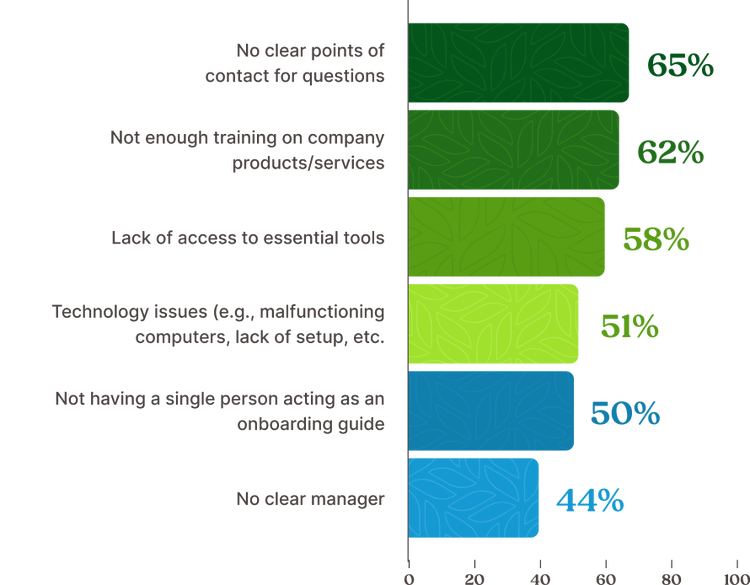
Read on to discover how to avoid these pitfalls—plus everything you need to know to build an onboarding process that’s destined to impress. We'll cover best onboarding practices, the benefits of consistent, inclusive onboarding, and helpful tools to hit all the right notes for every new hire.
*Editor's Note: All names and identifying information have been changed to protect privacy. Quotes have been lightly edited for clarity and concision.
What Is Onboarding?
Good onboarding introduces new hires to the expectations, skills, tools, people, culture, and other educational resources they need to be successful at your company. It also lays the groundwork for how the rest of the relationship will go and helps new hires anticipate the job’s potential impact on their long-term career goals.
As a form of “organizational socialization,” the onboarding experience marks an often emotional beginning of what’ll hopefully be a long and fruitful working relationship. And as many employees think of new positions as a way to launch or advance their careers—adding yet another layer of expectations—onboarding is an opportunity (for the company and new hires) to make a critical first impression.
Our 2023 survey revealed new hires' hopes and expectations about the onboarding experience:
87% of New Hires Hope to Make a Friend at Work
Employee onboarding is your opportunity to equip new hires with everything they need to succeed at your company, from best-foot-forward meet-and-greets with their immediate coworkers to clear expectations for how their performance will be measured.
And your efforts won’t go unappreciated: 87% of new hires hope to make a friend at work, which happens more easily when you facilitate opportunities for connection right off the bat.


44% of New Hires Regret Their Decision After the First Week
Onboarding for new employees—and for the company—is a critical time, especially during the first seven days. Nearly half (44%) actively regret their decision to join after the first week, and after the first month, 70% of your new hires will have officially made their decision to exit or stay.
This number jumps to 95% after the first two months. And remember, staying doesn’t mean new hires will be engaged in their work, just that they may choose to stay despite harboring regrets.
62% of Employees Say Their First Impressions of a New Company Are Still Accurate
New-hire onboarding is your chance as an organization to solidify the new person’s decision to come on board, commit to your mission, and do what you hired them to do to the best of their ability for as long as possible.
This makes first impressions incredibly important, with 62% of employees saying their first impressions of a new company are still accurate, and 60% agreeing that once made, a first impression is hard to change.


1 in 4 New Hires Will Cry Within Their First Week
To define onboarding as emotional is to acknowledge the universal experience of “first-day jitters.” Our same survey revealed that one in four new employees (23%) will cry within their first week at a new job.
So it’s important to structure those first few weeks of onboarding with a plan that’s specifically designed to convince new hires your company is worth it—the paycheck, the mental load, the time, the effort, and the emotion.
What's the Difference Between Orientation and Onboarding?
Orientation is a subset of activities couched inside an overarching onboarding process. It focuses on completing necessary paperwork and providing basic information about the company, including:
- History, mission, vision, and values
- Policies, procedures, and benefits
- Organizational structure
- Workplace rules
- Safety guidelines
Orientation can be as simple as sending an introductory packet before the new hire’s first day or scheduling group sessions during the first week. The primary goal is to familiarize new hires with the company's immediate expectations and help them navigate their new environment.


Onboarding is the more comprehensive and long-term process that extends beyond the initial orientation activities. It’s designed to integrate new hires into the company culture, help them understand their roles and responsibilities, and facilitate their successful transition into the organization.
Onboarding may include a mix of short- and long-term activities, including:
- Introductions to key team members
- Mentorship programs
- Job-specific training
- Goal-setting
- Performance feedback
- Continuous communication to address challenges or concerns
Onboarding can last for weeks or even months, depending on the complexity of the role and the organization. It involves providing ongoing support, training, and resources to new hires to ensure their productivity, engagement, and retention.
Types of Onboarding
For better or worse, your company’s onboarding processes—formal or informal, virtual or in-person—will say volumes about the way things are run at your organization. But that isn’t to say all of one and none of the others is the best approach.
Instead, think of where and how to blend the formal with the informal, and the virtual with in-person, for a comprehensive, flexible, and inclusive onboarding process.
Formal vs. Informal Onboarding
Onboarding exists on a spectrum of formal and informal approaches and processes. We recommend leading with a structured, formal onboarding process but leaving room for informal personal touchpoints along the way.
After accounting for all the necessities, like paperwork and IT support, and streamlining processes as much as possible, you can then focus on welcoming and integrating new people into an established organization with a more personal touch.
Formal onboarding processes are often associated with enterprises, but in truth any company can dial in a formal process for new hires.
A formal process provides clear structure and oversight, including:
- A defined onboarding timeframe with specific timelines and milestones
- A structured process for completing new-hire paperwork
- Scheduled training sessions, workshops, and shadowing opportunities
- Scheduled, staggered check-ins, performance assessments, or feedback sessions
- Assigned mentors, guides, or “onboarding buddies”
While formal onboarding can create consistency for new hires, there's a risk it may become inflexible or impersonal. And while it's important to treat all employees equally, a one-size-fits-all approach to education, training, and socialization could unintentionally discourage managers from accommodating new hires' needs on an individual basis.
- Faster or more predictable time to productivity
- Thorough new-hire training improves quality assurance
- Ensured check-ins and opportunities to socialize for new hires
- Set processes for gathering new-hire paperwork & signatures
- Intentional introduction to company culture, mission, and values
- Less flexible processes can feel rigid and unwelcoming
- Lack of personalization creates a one-size-fits-all approach and feelings of exclusion
- Less room to accommodate employees' specific needs
- Risk of information overload when training occurs within a tight timeframe
Informal onboarding describes a more organic and unstructured approach to integrating new hires, focusing more on learning as you go than facilitating guided interactions or trainings. Startups or small companies may take this approach by default, but sticking to this style of onboarding gets messy quickly.
In our survey, for example, one in five workers (20%) said their company didn’t do anything to facilitate networking or interpersonal support between new hires and their coworkers. This is an example of an informal, sink-or-swim style of onboarding.
- More opportunities for personalization and adaptability in situations where the structure may not be working for an individual
- Ongoing, informal communication around how the new hire is feeling and developing may feel more natural and approachable
- May fit new hires’ individual needs more flexibly and organically
- Knowledge transfer between senior employees and new hires is more custom and directly applicable to their day-to-day
- Important paperwork more likely to fall through the cracks
- Risk of workstations not being set up on time or even addressed
- New hires’ time to productivity may take longer than necessary
- Poor or incomplete training may lead to preventable errors
- Lack of oversight and direction may increase turnover
- No dependable timeline for new hires, managers, or HR
- No specific contact person for new hires may leave them feeling isolated
Virtual vs. In-Person Onboarding
Whether your new hire will be working in the office or a thousand miles away, every best onboarding practice mentioned in this guide still applies. Your onboarding process should prioritize the same goals for onboarding new hires, including:
- Familiarizing them with the company culture
- Helping them complete the necessary onboarding documents
- Providing them with the tools, training, and guidance they need to get up to speed
- Helping them feel included and welcome

- Office tour
- Introductory team lunch
- Signing physical onboarding paperwork
- Workstation setup and IT support
- Job shadowing and check-ins with a mentor or onboarding buddy
- Welcome video
- Food delivery gift cards and virtual meet-and-greet
- Digital pre-boarding packets with e-signatures
- Equipment delivery in time for first day
- Regular virtual 1:1s and pairing sessions with mentor
How Long Is the Onboarding Process?
An employee onboarding program can extend anywhere from a week to several months. Some companies may even schedule onboarding activities for their employees’ entire first year. Of course, what works best will depend on the role and organization.
In fact, employees themselves are fairly divided on what they like best. 86% of employees prefer having at least some time to ramp up, but more than half (56%) say they need just one or two days to ease into the swing of things.
Similarly, 36% of employees expressed frustration over long onboarding processes, citing boredom or feelings of exclusion—but 30% of employees want a slower, more gradual onboarding process before being expected to perform their full responsibilities.
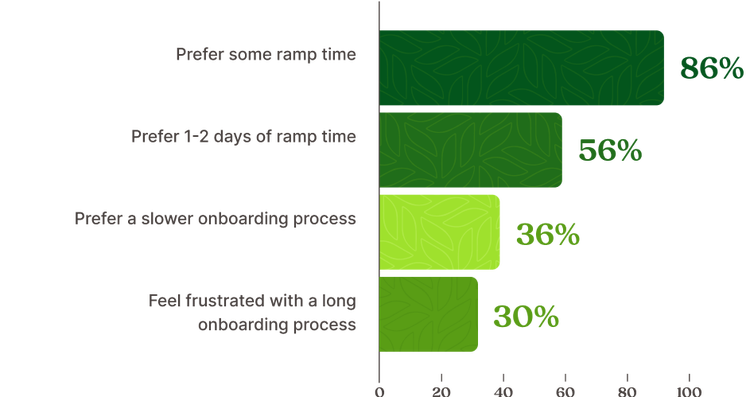
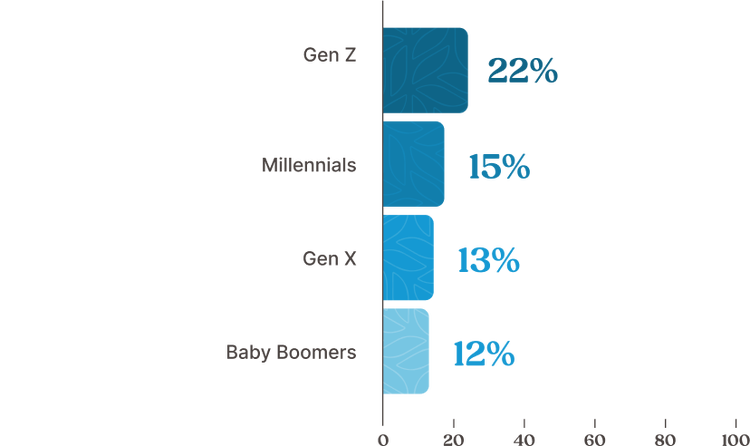
So how do you figure out what the right timeline is for your employees?
Collect feedback from new hires, so you know what to tweak or overhaul about your processes. And create specific goals for what you hope to achieve. It’ll be easier to pinpoint, measure, and assess the strong and weak points of a defined program than to fine-tune an informal, shoot-from-the-hip approach.
What Are the 4 Phases of Onboarding?
Before the First Day (1–2 weeks before)
- Craft a job offer.
- Negotiate salary.
- Complete new-hire paperwork.


New Hire Orientation (2–6 weeks)
- Offer a virtual or in-person facility tour.
- Introduce new hires to their teams.
- Introduce new hires to executives.
New Hire Training (1–6 months)
- Educate new hires on company policies, compliance, procedures, and more.
- Introduce company culture and values.
- Complete benefits selections.
- Provide job training.
- Offer guidance on roles and responsibilities, e.g., with an onboarding buddy.


Ongoing Support (Indefinite)
- Conduct a new-hire survey to get immediate feedback on the onboarding experience.
- Create regular check-ins between new hires and managers to create an ongoing feedback loop.
- Establish formal or informal mentors.
What Should an Onboarding Plan Address?

Compliance
Neglecting training on security and safety protocols, federally regulated policies, and other aspects of compliance exposes your organization to legal risk.
Clarification
Without clarity—about their role, your expectations, and the company’s organizational structure—even the most experienced new hire will have a hard time finding their feet at a new organization. Clarification is the essential onboarding pillar that’ll ensure a faster time to productivity.
Culture
This C introduces new hires to the formal and informal organizational norms of your workplace. Ideally guided by your mission, vision, and values, your company’s culture is its personality and compass, so failing to incorporate the Culture pillar into your onboarding rolls the dice on whether your new hires are ultimately pointed in the right direction.
Connection
Connection is more than getting familiar with an org chart—it should focus on facilitating productive, collaborative connections with key colleagues. And as the final of the Four Cs, it may mean the difference between having merely-there new hires by the end of the onboarding period or unleashing empowered, engaged professionals who are ready to hit the ground running.
How to Onboard New Employees in 10 Steps
1. Write a Detailed Job Description
This will echo the job posting that brought the new hire to you in the first place but must now include clear, detailed, and immediately applicable descriptions of the role’s expectations and responsibilities. This will also be what managers and supervisors use to evaluate employee performance.
Imagine the new hire referring to this document on a daily basis as they learn the ropes. Leave nothing out they’ll need to know to do the job to your standards and needs.


2. Craft a Compelling Job Offer
Be ready to send the offer immediately after you inform the candidate you’ve decided to hire them. To speed things up while still making sure everyone complies with your standards, start with a template that includes formalities, such as the terms of employment, salary and benefits, and other relevant details.
Make sure you can easily customize your template to include personal, genuine, and specific details from the new hire’s interview process. This will create a truly compelling job offer that results in an emphatic, “Yes!”
3. Create a Pre-Boarding Process
Establishing a pre-boarding process makes the transition smoother for new hires and gets boring paperwork out of the way, so you can focus on creating the best experience for their first day.
For example, BambooHR® Onboarding gets onboarding started before the first day with automated pre-boarding packets, e-signatures, Get to Know You questionnaires, and more.


4. Make a Good First Impression
At this point, you’ve made a good enough impression to secure an accepted offer, but now’s your chance to plan a welcome that solidifies their decision to join your cause.
Table stakes is equipping your new employees with the practical tools and resources they need to get started, but you have 44 days to do better than that—that’s the average time it takes for a new hire to solidify their first impression of a new company.
Failing to make a good first impression can leave new hires feeling misaligned or uncertain about their future at a company. Take Blake’s story, for example. We met Blake in November 2023, when we interviewed 40+ new hires at companies around the world about their experiences during the onboarding process, and their story highlights the importance of starting off on the right foot by honoring the information employees provide about their identities.
When Blake started a new job, they were pleased to be given the option to select nonbinary pronouns in their onboarding paperwork. But they were soon disappointed by the disconnect between pre-boarding and introductions with new coworkers. "She/her pronouns were still mostly used,” said Blake, “which kind of stinks.”
Although they tried to assume the best by acknowledging that some colleagues may have been unaware, the experience still stung. “It just didn't feel great on my part—like my identity wasn't honored."
5. Establish Your Organization's Culture and Values
If you want to build an exceptional workplace where great work gets done, it’s imperative to cultivate a strong company culture with clear and impactful values. Nearly all (96%) new hires want and expect their onboarding to include an introduction to the company's mission and values.
The best way to drive the message home is to share examples of how the values have guided business decisions in the past and continue to direct day-to-day operations. It’s important to emphasize and demonstrate how everyone is accountable to the values, especially leadership.
As an example of leaders setting the tone for a new hire’s onboarding experience, Tanya recalled watching a welcome video featuring the company’s CEO.
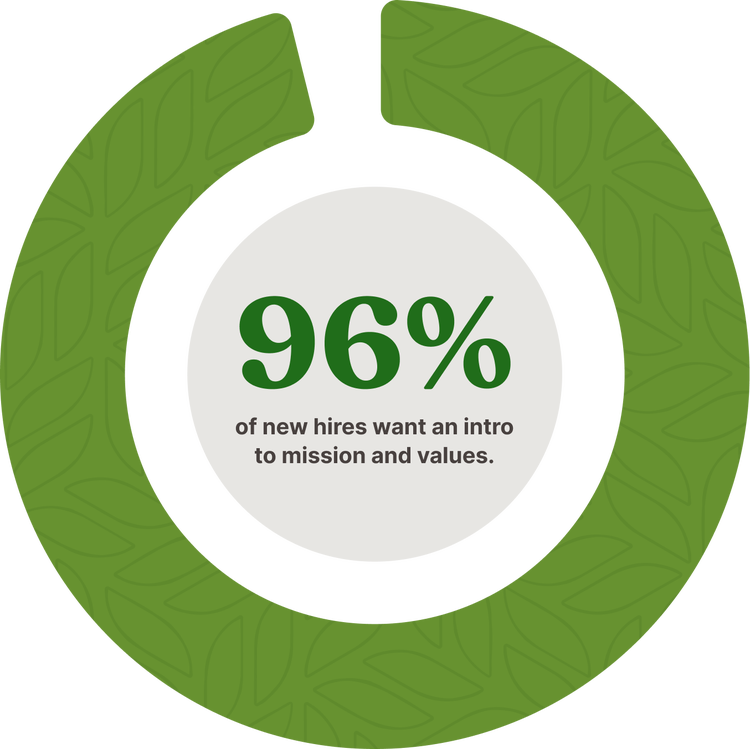


6. Introduce Your New Hire to the Team
Building relationships with colleagues is crucial for new hires to feel connected and supported. Encourage open communication and provide opportunities for new hires to ask questions and get to know their colleagues.
For example, HR can take the lead and organize introductions and meetings (virtual or in-person) with team members, managers, and key stakeholders.
After a decade-long hiatus from retail, Henrietta returned to the industry as an older employee with a lot of questions. Her new employer successfully built connections between Henrietta and her team so she would have all the support she needed.

7. Plan a Training Schedule
A training schedule guarantees no crucial skill or information gets overlooked, which can create unnecessary risk for your company and your new hire, too. This can include both general orientation topics, such as company policies and procedures, as well as job-specific training.
Provide resources, online modules, or assign mentors to guide new hires through the training process. As for the content some of this training should cover, Marcus had some advice:

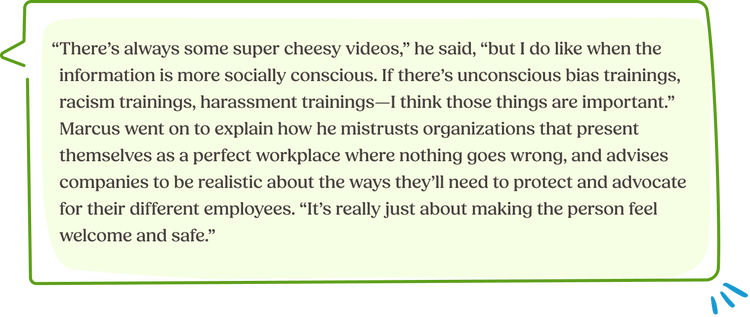

8. Set Expectations Around the Role and Performance
Clearly communicate expectations around the new hire's role and performance. Managers should use the job description to:
- Set goals, objectives, and performance metrics that align with the company's overall objectives.
- Provide regular feedback and guidance to help new hires understand how they’re progressing and what areas they can focus on for improvement.
This process works best when it's an ongoing conversation. When Erik joined a new company, he was impressed by how open and easygoing the team's leaders were.
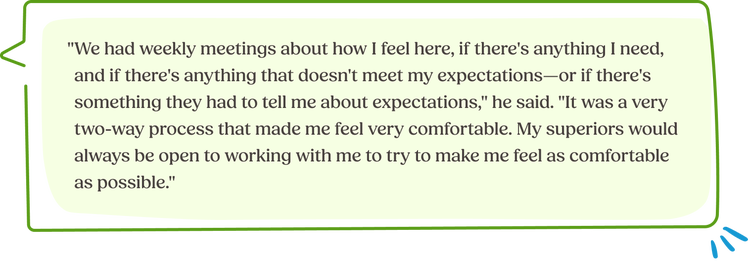
9. Provide Ongoing Support and Feedback
Setting up a check-in cadence for managers also helps new hires feel valued and supported as you give them opportunities to receive and provide feedback early and often throughout the process.
Having an attentive supervisor who was always available made all the difference in Lyle’s onboarding experience:
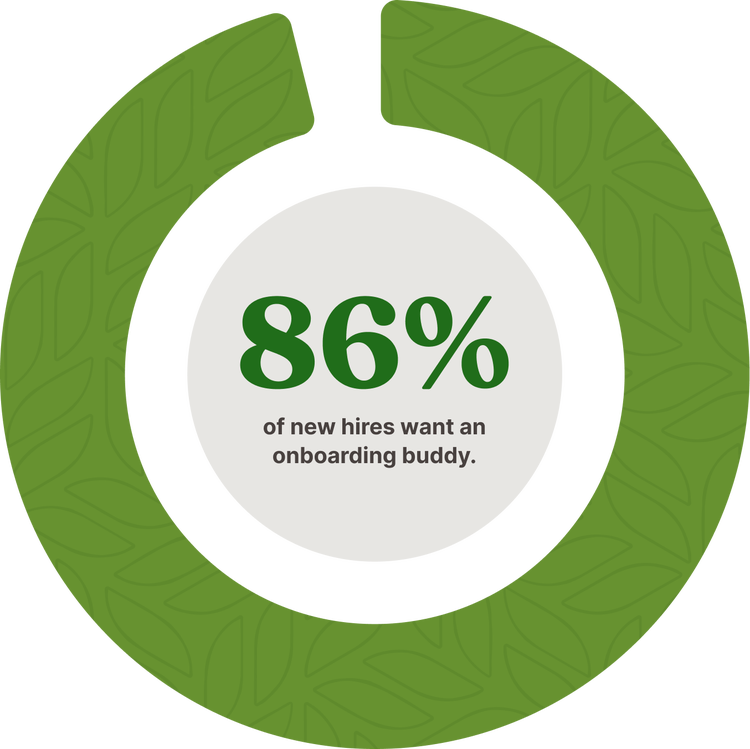


10. Re-Board When Necessary
Re-boarding is necessary when employees have been absent for a period of time or are transitioning to a new role within the company. Substantial organizational changes can also call for re-boarding, which can involve revisiting certain trainings, setting new goals, or providing additional resources.
Regularly assessing an employee’s progress and making adjustments as needed ensures their continued engagement and long-term success.
The Top 9 Benefits of Onboarding
1. Increased Productivity
Good onboarding doesn’t just increase a new employee’s capacity for productivity. It also boosts a key HR and onboarding metric—time to productivity (TTP), which describes the time it takes for new hires to acclimate and start contributing at full steam.
2. Increased Retention
65% of employees know if a job is the right fit within the first month, which means every second of those first 30 days will make or break your retention metrics. As you welcome new hires with effective onboarding, you build a strong case for staying long-term at your company.
3. Improve Understanding of Role and Expectations
Onboarding should provide new hires a clear understanding of their role, your expectations, and the performance metrics you’ll use to assess them. This sets them and their supervisors up for a meaningful first performance review, complete with aligned expectations and actionable feedback.
4. Improved Understanding of Company Culture and Team Dynamics
No company is too large or profitable to be immune to “broken culture syndrome” and its toxic, foundation-crumbling effects, but an ounce of prevention is worth a pound of cure. Onboarding ensures new hires understand and align with your org’s culture, values, and norms from the beginning, and directs the course of your mutual long-term success.
5. Minimize Wasted Investments
Losing a single new hire to early turnover can cost you between $7,500 to $28,000 in sunk costs. Failing to implement an onboarding strategy is like dropping the same amount of chips on a craps table and rolling the dice. There’s no reason to take that kind of risk with your hiring investment. Onboarding hedges your bets and paves the way for exponential growth.
6. Create Comfortable Employees
One of our new-hire interviewees, Lyle, shared a little about his onboarding experience as someone with autism, and what contributed most to his comfort as a new employee.

7. Increase Transparency
Onboarding is your chance to reinforce promises made during recruitment and set up realistic expectations for the future. It’s also your chance to reduce uncertainties and mitigate anxieties by being upfront about how your organization will serve to advance their own goals as they contribute to yours.
8. Build a Sense of Trust
The best onboarding creates an inclusive culture where every employee can thrive in mutual trust and respect. A few of our interviewees shared their thoughts on how HR can create an inclusive onboarding experience.
For Emma, whose mental health condition qualifies for protection under US federal law, it was important to be treated just like anyone else. “I don't want my colleagues, my coworkers, or my bosses to see me differently,” she said. “That would induce anxiety for me. I'm happy to fly under the radar and just be seen as one of the herd.”
Jon expressed similar sentiments. “We kind of focused on training and not so much on my identity,” he said. “I don't think my identity played a role in any of these interactions at all, which is what I wanted.”
9. Reduce Workload for Other Teams
Effective onboarding produces confident, self-sufficient new hires who are less prone to making mistakes others in the company will need to fix. Additionally, when new hires are given a designated and equipped support system as part of their onboarding experience, other employees and teams aren’t being pulled from their work to offer impromptu support and training.
Expert Tips for Improving the Onboarding Process
HR pros are experts at spotting poor onboarding practices.
We found that 79% of HR professionals know if a job is going to be a good fit for them within the first month, compared to 65% of other workers. It’s especially unfortunate when a poor onboarding experience repels the very people who'd be tasked with improving it.
So how do you begin improving the onboarding process at your company?

Keep Track of What Works and What Doesn’t
Regularly review and update your onboarding program to incorporate best practices, industry trends, and feedback from stakeholders (e.g., HR, hiring managers, and new hires themselves). New-hire surveys should be a part of every onboarding strategy, as well as staying up to date with new technologies and tools that can enhance the onboarding experience.
Create Room for Flexibility and Personalization as Needed
A standardized process doesn’t work for every situation, which is why your onboarding should be prepared to evolve and adapt to the changing needs of your organization, and even the individual needs of your new hires.
For Emma, a new job came with an overwhelming amount of online training—much of it irrelevant to her specific role. "It's hours and hours of training that I have to do on my own unpaid time outside of work hours," she said. “It's just something that everybody has had to do, but a lot of it is irrelevant to my role. It’s very frustrating."
In situations like this, HR pros have an opportunity—and a responsibility—to seek out feedback and advocate for more efficient practices that reduce employees' discontent.
Define Trackable Metrics to Gauge Success
Establish key performance indicators (KPIs) or metrics to measure the effectiveness of your onboarding process. These metrics could include employee retention rates, time to productivity, engagement levels, or feedback scores.
By tracking these metrics, you can objectively evaluate the impact of your onboarding efforts and identify areas for improvement.
Be Receptive to Feedback and Quick to Accommodate
Create a culture of open communication from day one by actively seeking feedback from new hires and other stakeholders involved in the onboarding process. Encourage them to share their experiences, suggestions, and concerns during or immediately after their onboarding period. Be responsive to their feedback and make necessary accommodations or adjustments to address issues or gaps they’ve identified.
Pro tip: If requesting feedback from a large number of employees or new hires, provide a way to give it anonymously to encourage honest (i.e., critical) feedback—the most useful type of feedback you can hope for if your goal is to improve.
Discover the Best Tools for Onboarding
Truly effective onboarding relies on the humans on your team—the recruiters, hiring managers, mentors, and other teammates—who'll welcome, support, and encourage new hires.
But technology can be a powerful assistant to the onboarding process—and new hires expect it to play a role in their onboarding experience. 97% of our survey respondents say it’s important for onboarding to include tools and software the company uses to streamline the process, and 81% call it “crucial.”
In fact, onboarding software can set HR pros and people managers free to delve even more deeply into the nuances of truly effective, human-to-human onboarding.
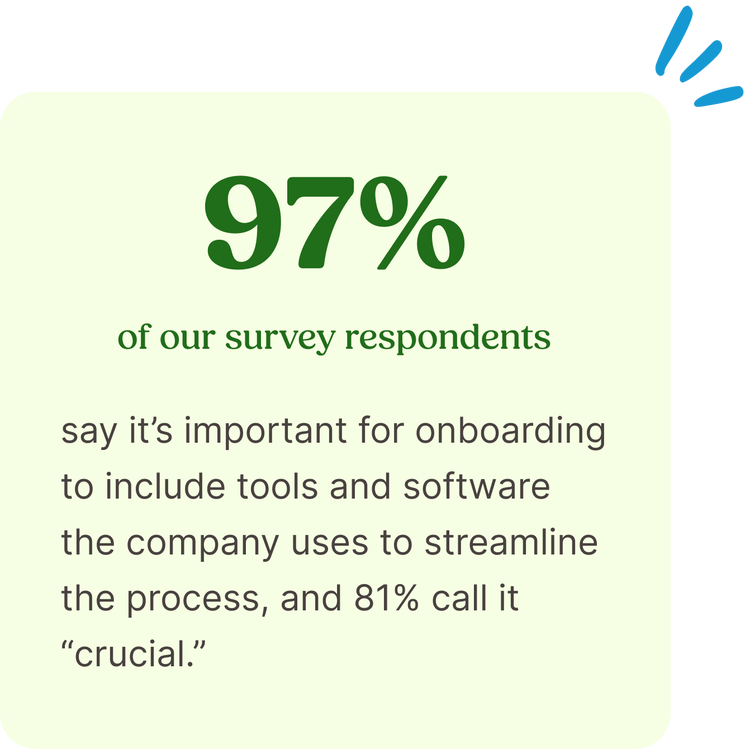

Onboarding Process Automation
When you use HR onboarding software for new employees, you'll get access to prebuilt, automated workflows, checklists, and other time-saving features, such as:
- Custom offer letter templates
- Personalized welcome emails
- Total rewards statements
- Pre-assembled digital new-hire packets
- Digital pre-boarding paperwork and e-signatures
- Automated self-boarding checklists
- Post-onboarding new-hire surveys
- Digital document storage and organization
For example, BambooHR® provides all of the above and more, including a Get to Know You questionnaire as part of the new-hire pre-boarding packet.
New employees shouldn’t have to learn their way around your company from the school of hard knocks. Give them the welcome and tools they need to have a positive experience and watch them thrive alongside your company.
Create better first days.
BambooHR helps you build an effective onboarding process with customizable onboarding checklists, welcome emails, and new hire packets—so every new hire feels welcome on day one.
Onboarding FAQs
Who should be involved in employee onboarding?
Everyone in the company plays a part in helping new hires feel welcome and comfortable, but your key contributors will be HR, hiring managers, mentors, and those coworkers who'll be working closely with the new hire in their day-to-day tasks.
Can you start onboarding before the employee’s first day?
Absolutely. In fact, when you leverage pre-boarding packets, you can get all the paperwork and formalities out of the way so the new hire’s first day can be all about making connections and getting to know your company’s culture.
How do you develop an onboarding process for the first time?
Start by defining clear objectives for your onboarding and a way to measure success. Then create a structured plan for incorporating company culture, providing necessary resources, and seeking feedback for continuous improvement.
Looking for More HR Insights? Keep Reading
First Impressions Are Everything: 44 Days to Make or Break a New Hire
70% of new hires decide whether a job is the right fit within the first month—including 29% who know within the first week. Onboarding makes all the difference.
Free Download: Get the Definitive Guide to Company Culture
Want a vibrant workplace that supports employees and helps your organization achieve its goals? Our guide offers a step-by-step plan for leveling up your company culture.
31% of HR Managers Say They Need Better Employee Data Protection
Discover insights into employee perception and experience with data security—and how to better protect your workforce data.
